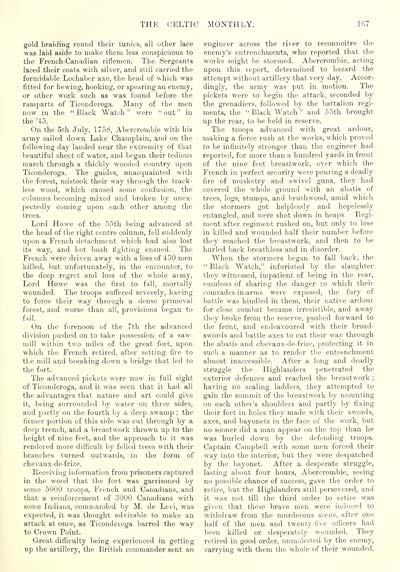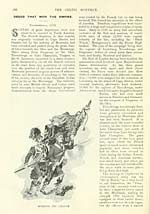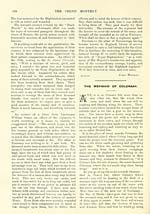Blair Collection > Celtic monthly > Volume 6, 1898
(243)
Download files
Complete book:
Individual page:
Thumbnail gallery: Grid view | List view

THK CELTIC MONTHLY.
16"
gold braiding round their tunics, all other lace
was laid aside to make them less conspicuous to
the French-Canadian riflemen. The Sergeants
laced their coats with silver, and still carried the
formidable Lochaber axe, the head of \shich was
fitted for hewing, hooking, or spearing an enemy,
or other work .such as was found before the
ramparts of Ticocderoga. Many of the men
now in the " Black Watch " wore " out " in
the '45.
On the 5lh July, 1758, Abercrombie with his
army sailed down Lake Champlain, and on the
following day landed near the extremity of that
beautiful sheet of water, and began their tedious
march through a thickly wooded country upon
Ticonderoga. The guides, unacquainted with
the forest, mistook their way through the track-
le.ss wood, which caused some confusion, the
columns becoming mixed and broken by unex-
pectedly coming upon each other among the
trees.
Lord Howe of the 55th being advanced at
the head of the right centre column, fell suddenly
upon a French detachment which had also lost
its way, and hot bush fighting ensued. The
French were driven away with a loss of 430 men
killed, but unfortunately, in the encounter, to
the deep regret and loss of the whole army.
Lord Howe was the first to fall, mortally
wounded. The troops suffered severely, having
to force their way through a dense primeval
forest, and worse than all, provisions began to
Ml
On the forenoon of the 7th the advanced
division pushed on to take possession of a saw-
mill within two miles of the great fort, upon
which the French retired, after setting fire to
the mill and breaking down a bridge that led to
the fort.
The advanced pickets were now in full sight
of Ticonderoga, and it was seen that it had all
the advantages that nature and art could give
it, being surrounded by water on three sides,
and pirtly on the fourth by a deep swamp ; the
firmer portion of this side was cut through by a
deep trench, and a breastwork thrown up to the
height of nine feet, and the approach to it was
rendered more difficult by felled trees with their
branches turned outwards, in the form of
chevaux-de-frize.
Receiving information from prisoners captured
in the wood that the fort was gairisoned by
some 5000 troops, French and Canadians, and
that a reinforcement of 3000 Canadians with
some Indians, commanded by M. de Levi, was
expected, it was thought advisable to make an
attack at once, as Ticonderoga barred the way
to Crown Point.
Great difficulty being experienced in getting
up the artillery, the British commander sent an
engineer across the river to reconnoitre the
enemy's entrenchments, who reported that the
works might be stormed. Abercrombie, acting
upon this leport, determined to hazard the
attempt without artillery that very day. Accor-
dingly, the array was put in motion. The
pickets were to begin the attack, seconded by
the grenadiers, followed by the battalion regi-
ments, the " Black Watch " and 55th brought
up the rear, to be held in reserve.
The troops advanced with great ardour,
making a fierce rush at the works, which proved
to be infinitely stronger than the engineer had
reported, for more than a hundred yards in front
of the nine feet breastwork, over which the
French in perfect security were pouring a deadly
fire of musketry and swivel guns, they had
covered the whole ground with an abatis of
trees, logs, stumps, and brushwood, amid which
the stormers got helplessly and hopelessly
entangled, and were shot down in heaps. Regi-
ment after regiment rushed on, but only to lose
in killed and wounded half their number before
they reached the breastwork, and then to be
hurled back breathless and in disorder.
When the stormers began to fall back, the
" Black Watch," infuriated by the slaughter
they witnessed, impatient of lieing in the rear,
emulous of sharing the danger co which their
comrades-in-arms weie exposed, the fury of
battle was kindled in them, their native ardour
for close combat became irresistible, and away
they broke from the reserve, pushed forward to
the front, and endeavoured with their broad-
swords and battle axes to cut their way through
the abatis and chevaux-de-frize, protecting it in
such a manner as to render the entrenchment
almost inaccessible. After a long and deadly
struggle the Highlanders penetrated the
exterior defences and reached the breastwork ;
having no scaling ladders, they attempted to
gain the summit of the breastwork by mounting
on each other's shoulders and partly by fixing
their feet in holes they made with their swords,
axes, and bayonets in the face of the work, but
no sooner did a man appear on the top than he
was hurled down by the defending troops.
Captain Campbell with .some men forced their
way into the interior, but they were despatched
by the bayonet. After a desperate struggle,
lasting about four hours, Abercrombie, seeing
no possible chance of success, gave the order to
retire, but the Highlanders still persevered, and
it was not till the third order to retire was
given that these brave men were induced to
withdraw from the murderous scene, after one
half of the men and twenty- five officers had
been killed or desperately wounded. They
retired in good order, unmolested by the enemy,
carrying with them the whole of their wounded.
16"
gold braiding round their tunics, all other lace
was laid aside to make them less conspicuous to
the French-Canadian riflemen. The Sergeants
laced their coats with silver, and still carried the
formidable Lochaber axe, the head of \shich was
fitted for hewing, hooking, or spearing an enemy,
or other work .such as was found before the
ramparts of Ticocderoga. Many of the men
now in the " Black Watch " wore " out " in
the '45.
On the 5lh July, 1758, Abercrombie with his
army sailed down Lake Champlain, and on the
following day landed near the extremity of that
beautiful sheet of water, and began their tedious
march through a thickly wooded country upon
Ticonderoga. The guides, unacquainted with
the forest, mistook their way through the track-
le.ss wood, which caused some confusion, the
columns becoming mixed and broken by unex-
pectedly coming upon each other among the
trees.
Lord Howe of the 55th being advanced at
the head of the right centre column, fell suddenly
upon a French detachment which had also lost
its way, and hot bush fighting ensued. The
French were driven away with a loss of 430 men
killed, but unfortunately, in the encounter, to
the deep regret and loss of the whole army.
Lord Howe was the first to fall, mortally
wounded. The troops suffered severely, having
to force their way through a dense primeval
forest, and worse than all, provisions began to
Ml
On the forenoon of the 7th the advanced
division pushed on to take possession of a saw-
mill within two miles of the great fort, upon
which the French retired, after setting fire to
the mill and breaking down a bridge that led to
the fort.
The advanced pickets were now in full sight
of Ticonderoga, and it was seen that it had all
the advantages that nature and art could give
it, being surrounded by water on three sides,
and pirtly on the fourth by a deep swamp ; the
firmer portion of this side was cut through by a
deep trench, and a breastwork thrown up to the
height of nine feet, and the approach to it was
rendered more difficult by felled trees with their
branches turned outwards, in the form of
chevaux-de-frize.
Receiving information from prisoners captured
in the wood that the fort was gairisoned by
some 5000 troops, French and Canadians, and
that a reinforcement of 3000 Canadians with
some Indians, commanded by M. de Levi, was
expected, it was thought advisable to make an
attack at once, as Ticonderoga barred the way
to Crown Point.
Great difficulty being experienced in getting
up the artillery, the British commander sent an
engineer across the river to reconnoitre the
enemy's entrenchments, who reported that the
works might be stormed. Abercrombie, acting
upon this leport, determined to hazard the
attempt without artillery that very day. Accor-
dingly, the array was put in motion. The
pickets were to begin the attack, seconded by
the grenadiers, followed by the battalion regi-
ments, the " Black Watch " and 55th brought
up the rear, to be held in reserve.
The troops advanced with great ardour,
making a fierce rush at the works, which proved
to be infinitely stronger than the engineer had
reported, for more than a hundred yards in front
of the nine feet breastwork, over which the
French in perfect security were pouring a deadly
fire of musketry and swivel guns, they had
covered the whole ground with an abatis of
trees, logs, stumps, and brushwood, amid which
the stormers got helplessly and hopelessly
entangled, and were shot down in heaps. Regi-
ment after regiment rushed on, but only to lose
in killed and wounded half their number before
they reached the breastwork, and then to be
hurled back breathless and in disorder.
When the stormers began to fall back, the
" Black Watch," infuriated by the slaughter
they witnessed, impatient of lieing in the rear,
emulous of sharing the danger co which their
comrades-in-arms weie exposed, the fury of
battle was kindled in them, their native ardour
for close combat became irresistible, and away
they broke from the reserve, pushed forward to
the front, and endeavoured with their broad-
swords and battle axes to cut their way through
the abatis and chevaux-de-frize, protecting it in
such a manner as to render the entrenchment
almost inaccessible. After a long and deadly
struggle the Highlanders penetrated the
exterior defences and reached the breastwork ;
having no scaling ladders, they attempted to
gain the summit of the breastwork by mounting
on each other's shoulders and partly by fixing
their feet in holes they made with their swords,
axes, and bayonets in the face of the work, but
no sooner did a man appear on the top than he
was hurled down by the defending troops.
Captain Campbell with .some men forced their
way into the interior, but they were despatched
by the bayonet. After a desperate struggle,
lasting about four hours, Abercrombie, seeing
no possible chance of success, gave the order to
retire, but the Highlanders still persevered, and
it was not till the third order to retire was
given that these brave men were induced to
withdraw from the murderous scene, after one
half of the men and twenty- five officers had
been killed or desperately wounded. They
retired in good order, unmolested by the enemy,
carrying with them the whole of their wounded.
Set display mode to: Large image | Transcription
Images and transcriptions on this page, including medium image downloads, may be used under the Creative Commons Attribution 4.0 International Licence unless otherwise stated. ![]()
| Early Gaelic Book Collections > Blair Collection > Celtic monthly > Volume 6, 1898 > (243) |
|---|
| Permanent URL | https://digital.nls.uk/75857456 |
|---|
| Shelfmark | Blair.58 |
|---|---|
| Additional NLS resources: | |
| Attribution and copyright: |
|
| Description | A selection of books from a collection of more than 500 titles, mostly on religious and literary topics. Also includes some material dealing with other Celtic languages and societies. Collection created towards the end of the 19th century by Lady Evelyn Stewart Murray. |
|---|
| Description | Selected items from five 'Special and Named Printed Collections'. Includes books in Gaelic and other Celtic languages, works about the Gaels, their languages, literature, culture and history. |
|---|

